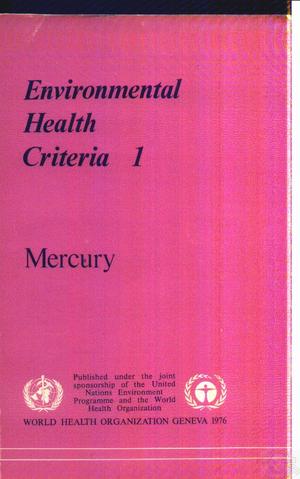Mercury
İÇİNDEKİLERCONTENTSBACKGROUND AND PURPOSE OF THE WHO ENVIRONMENTAL HEALTH CRITERIA PROGRAMME ENVIRONMENTAL HEALTH CRITERIA FOR MERCURY. 1. SUMMARY AND RECOMMENDATIONS FOR FURTHER RESEARCH 1.1 Some definitions 1.2 Summary 1.2.1 Analytical methods 1.2.2 Sources of environmental pollution 1.2.3 Environmental distribution and transport 1.2.4 Environmental exposure levels 1.2.5 Metabolism-of mercury 1.2.6 Experimental studies on the effects of mercury 1.2.7 Epidemiological and clinical studies 1.2.8 Evaluation of health risks to man and guidelines for health protection 1.3 Recommendations for further research .3.1 Environmental sources and pathways of mercury intake . .3.2 Metabolic models in man .3.3 Epidemiological studies .3.4 Interaction of mercury with other environmental factors . .3.5 Biochemical and physiological mechanisms of toxicity . 2. PROPERTIES AND ANALYTICAL METHODS 2.1 Chemical and phhysical properties 2.2 Purity of compounds 2.3 Sampling and analysis 2.3.1 Sample collection 2.3.2 Analytical methods 2.3.3 Analysis of alkyl mercury compounds in the presence of inorganic mercury 3. SOURCES OF ENVIRONMENTAL POLLUTION 3.1 Natural occurrence 3.2 Industrial production 3.3 Uses of mercury 3.4 Contamination by fossil fuels, waste disposal, and miscellaneous industries. 4. ENVIRONMENTAL TRANSPORT, DISTRIBUTION, AND TRANSFORMATION. 4.1 Distribution between media-the global mercury cycle 4.2 Environmental transformation-the local mercury cycle 4.3 Interaction with physical or chemical factors 4.4 Bioconcentration 5. ENVIRONMENTAL LEVELS AND EXPOSURES 5.1 Levels in air, water, and food 5.2 Occupational exposures 5.3 Estimate of effective human exposure 6. METABOLISM OF MERCURY 6.1 Uptake 6.1.1 Uptake by inhalation 6.1.2 Uptake by ingestion 6.1.3 Absorption through skin 6.2 Distribution in organisms 6.3 Elimination in urine and faeces 6.4 Transplacental transfer and secretion in milk 6.5 Metabolic transformation and rate of elimination . 6.6 Accumulation of mercury and biological half-time (metabolic model) . . . 6.7 Individual variations-strain and species comparisons 7. EXPERIMENTAL STUDIES ON THE EFFECTS OF MERCURY 7.1 Experimental animal studies 7.1.1 Acute studies 7.1.2 Subacute and chronic studies 7.1.2.1 Reversible damage 7.1.2.2 Irreversible damage . 7.1.2.3 Interactions with physical and chemical factors . 7.1.3 Biochemical and physiological mechanisms of toxicity 8. EFFECTS OF MERCURY ON MAN-EPIDEMIOLOGICAL AND CLINICAL STUDIES 8.1 Epidemiological studies 8.1.1 Occupational exposure to mercury vapour, alkylmercury vapour and other exposures 8.1.2 General population 8.1.3 Children and infants with in utero exposure 8.2 Clinical studies of effects of mercury binding compounds 8.3 Pathological findings and progression of disease 8.3.1 Psychiatric and neurological disturbances 8.3.2 Eye and visual effects 8.3.3 Kidney damage 8.3.4 Skin and mucous membrane changes 9. EVALUATION OF HEALTH RISKS TO MAN FROM EXPOSURE TO MERCURY AND ITS COMPOUNDS 9.1 General considerations 9.1.1 Elemental mercury vapour 9.1.2 Methylmercury compounds 9.1.3 Ethylmercury compounds and other short-chain alkylmercurials . . 9.1.4 Inorganic mercury, aryl- and alkoxyalkylmercurials 9.2 Summary and guidelines REFERENCES...... NOTLAREnvironmental Health Criteria 1   |



